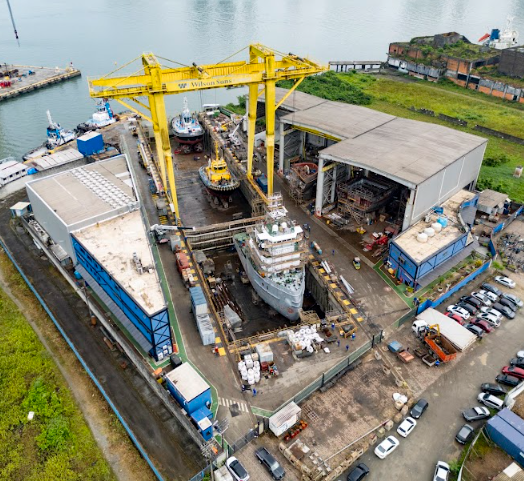Wilson Sons, a leader in port and maritime logistics in Brazil, carried out simultaneous docking of three vessels, from different shipowners, at its shipyards in Guarujá (São Paulo), located in the Port of Santos, which is Latin America’s leading port facility. More than 120 workers were involved in the 15-day operation, using cutting-edge technology.
The three docked vessels operate in the Southeast (in the states of São Paulo, Rio de Janeiro and Espírito Santo) and South (Santa Catarina) of Brazil. Scheduled maintenance included measuring and replacing steel sheets and anodes, treatment and painting internally (tanks and compartments) and externally (hulls), valve servicing, repairs to propulsion systems and engines.

In addition to the three simultaneous dockings, the company is building, at its shipyards in Guarujá, a new tug with more sustainable technology, WS Onix. It is part of a building project of six tugs that are the first in Brazil to follow the IMO TIER III standard established by the International Maritime Organization. Their innovative hull design leads to reduced greenhouse gas emissions and an estimated decrease of 14% in the consumption of fossil fuels, supporting the improvement of air quality in the ports where they operate.
Five of these 90-ton bollard pull tugs have been delivered since July 2022 (WS Centaurus, WS Orion, WS Rosalvo, WS Castor and WS Dorado — baptized in March). The new vessels have carried out over 3,500 docking and undocking manoeuvres on the Brazilian coast. WS Onix, in turn, will be launched later this year.
Dike system with intermediate floodgates
Wilson Sons has been operating in the Port of Santos for over 80 years. Its shipyard is equipped with special operating facilities to perform docking services simultaneously and these include the intermediate floodgate of its dike system. This type of floodgate can only be found at Wilson Sons’ shipyard, and its main function is to provide operating flexibility, allow vessel space, and offer partially flooding capabilities, as required in the operations.
It is used to control the water level between different sections and regulate the flooding process, which provides important benefits. Technology allows vessels to operate more efficiently — using the shipyard’s resources, without requiring any external equipment. Furthermore, the teams have easier access to the hull and the interior of the vessel. This results in reduced docking times and more efficient use of resources in maintenance, repair and inspection operations, increasing the speed and quality of services, as well as reducing costs.
Support to environmental sustainability is another advantage of the intermediate floodgate. The ability to control the water level in the docking operation minimizes waste and ensures safety.
Higher demand for docking services
Between 2022 and 2023, the number of docking operations rose by 33%; and this growth rate is expected to be maintained this year. With two shipyard facilities in Guarujá, totalling 39,000 m² for ship building, conversion, maintenance and repair, Wilson Sons is the only company that owns a dry dock in the Port of Santos, offering pioneering and innovative service solutions.










